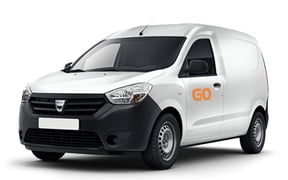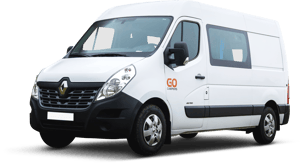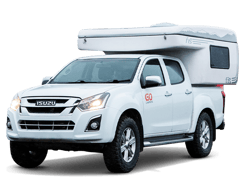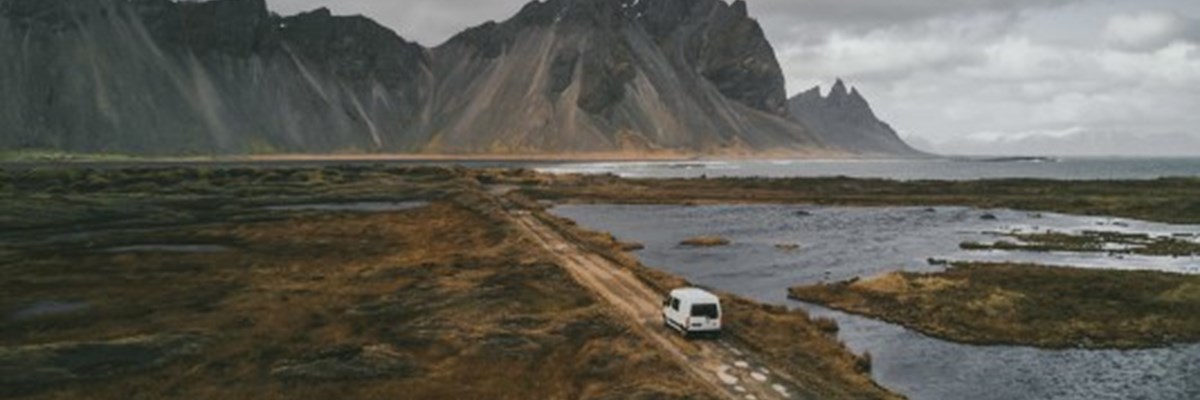
Two Week Iceland Ring Road Itinerary
Go to chapter
- Day 1: The Golden Circle & Secret Lagoon
- Day 2: Secrets of the Thjórsárdalur Valley
- Day 3: The South Coast
- Day 4: Fjaðrárgljúfur and Skaftafell
- Day 5: Jökulsárlón Glacier Lagoon and the East Fjords
- Day 6: Lagarfljót, Egilsstaðir, and Seyðisfjörður
- Day 7: Dettifoss and Mývatn
- Day 8: Whale Watching and Akureyri
- Day 9: Hot Springs in Northwest Iceland
- Day 10: The Westfjords
- Day 11: Dynjandi and Látrabjarg
- Day 12: Snæfellsnes Peninsula
- Day 13: Snæfellsjökull National Park and the Southern Shore
- Day 14: Glymur Waterfall and Reykjavík
Embarking on a two-week journey along Iceland's iconic Ring Road is a dream come true for many travelers. To make the most of this adventure, consider the convenience of Iceland campervan rental. Our guide on Iceland campervan rental provides valuable insights into selecting the perfect vehicle for your itinerary, ensuring you have the flexibility and comfort needed for a memorable trip. From the stunning waterfalls to the dramatic landscapes and charming villages, this itinerary will take you on a captivating journey through Iceland's diverse landscapes. With Iceland campervan rental, you can explore the beauty of Iceland with ease and freedom, making the most of your two-week adventure.
This ideal 14-day self-drive itinerary for campervans takes in the country’s best sights and unexplored areas in 2 weeks. This itinerary highlights its advantages on traveling with a campervan in Iceland.
Day 1: The Golden Circle & Secret Lagoon
Like most itineraries, we recommend after picking up your camper that you head immediately towards the Golden Circle. It’s always a good introduction to the country, and you’ll quickly appreciate the fact that you’ve visited the busiest area of Iceland first as the tourists drop away later in your trip.
The Golden Circle is usually filled with tourist buses year-round, but with a campervan, you can stop at some locations that the tour buses don’t. Read our complete guide to discovering the Golden Circle in your campervan and you’ll discover some under the radar locations to visit on your first day.
We highly recommend camping at Flúðir for your first night on the road. There is loads of space for campervans, clean bathrooms, and most importantly, free hot showers. Plus, the town is also home to the Secret Lagoon, the perfect hot spring for a late afternoon/early evening dip.
Day 2: Secrets of the Thjórsárdalur Valley
Day two on the itinerary is jam-packed, so get up early and hit the road as soon as you can. From Flúðir, drive south until you hit road number 32, which turns northeast and takes you up into the Thjórsárdalur Valley. Despite its proximity to such crowded areas as the Golden Circle and the South Coast, this area of the country remains delightfully quiet, and the scenery is out of this world.
Make your way to the waterfall Hjálparfoss, and then afterward turn north onto Road 327. Along here you will be able to reach the parking area of Stöng, a longhouse from the Viking era which is fun to explore. From the same carpark, you can also hike for 30 minutes further along the road to Gjáin, a small oasis of luscious greenery, rushing waterfalls and rocky caves. It’s important not to attempt to drive here though, as the road is incredibly rough, and we don’t want to have to charge for damage to the undercarriage of the camper when you return.
Once you’re back in the camper, backtrack to road 32 and then continue for a little bit further northeast until you reach another turn off. Campers can handle the road up to the Gljásteinn Hólaskógur Hostel, where you can leave your camper and then hike the 1–1.5 hours to the waterfall Háifoss. This is Iceland’s third tallest waterfall and an incredible sight that not many people get to see.
All this careful driving and hiking will chew up most of your day, but it’s not over yet. Spend the late afternoon driving back down towards Route 1 along road 26, past the volcano Hekla. The road is rough so take it easy and enjoy the incredible scenery along the way. Camp at Laugaland Campsite for the evening.
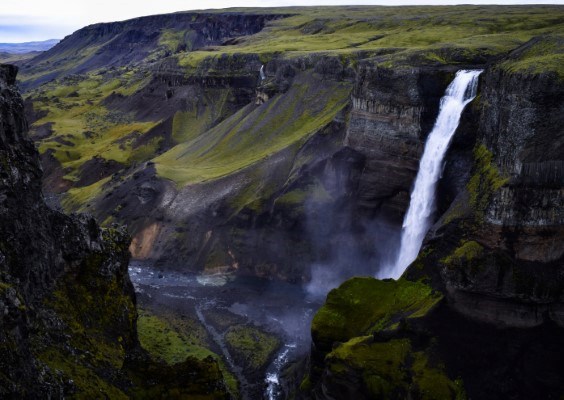
Day 3: The South Coast
After an adventurous detour on day 2, it’s time to re-join the crowds along the south coast. This area of Iceland is one of the most popular, but with good reason. The scenery here is incredible: waterfalls tumble off the highland shelf, black sand beaches are pummelled by the steely grey ocean, and all the while the icy glaciers Eyjafjallajökull and Mýrdalsjökull stand guard over the explosive landscapes of the highlands just mere kilometers away.
Stop off at Seljalandsfoss, take a dip at the hot spring Seljavallalaug, and then visit the waterfall Skogafoss. Hike out towards the abandoned plane on Sólheimasandur Beach, visit the Dyrhólaey peninsula for the amazing views, and check out the Reynisfjara Black Sand Beach as well. There’s a lot to see so you won’t cover much ground; we recommend the campsite at Vík.
For more details, check out our in-depth guide to South Iceland.
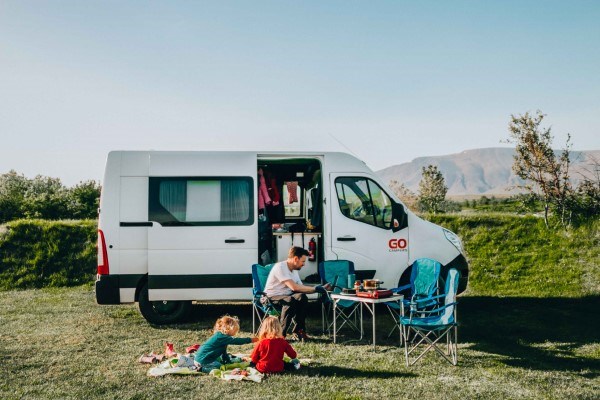
Day 4: Fjaðrárgljúfur and Skaftafell
After an action-packed first three days of the campervan trip, the first half of day four will be spent cruising along the ring road towards the southeast. Make a quick pit stop at Fjaðrárgljúfur canyon (if it’s open) to see the area made famous by Justin Bieber’s irresponsible jumping around (stick to the paths). But the main aim for the day is to get to Skaftafell around lunchtime, so you’ve got a good amount of time to enjoy some of the trails in one of Iceland’s best destinations for hiking.
The most accessible hiking trail leads to Svartifoss, a picturesque waterfall set in front of black basalt columns. From here, you can also continue hiking up to the viewpoint of Sjónarnípa (east of Svartifoss) where you’re afforded an amazing vista over the glacier tongue Skaftafellsjökull.
For a campsite, you can either opt to stay at Skaftafell (ideal if you want to get in a quick hike on day 5), but we really like the nearby campsite of Svínafell, which is a little more affordable, has free showers, and get you closer to the Glacier Lagoon for the morning.
Day 5: Jökulsárlón Glacier Lagoon and the East Fjords
Jökulsárlón is probably the biggest and most popular sight on the ring road and is also a great spot to access the glacier activities like snowmobiling, hiking, and the ice caves (winter only). The earlier you arrive at the lagoon the quieter it will be. Also don’t forget to hop over the road and check out the black sand beach, dubbed ‘Diamond Beach’ thanks to the icebergs washed up onto the shore melting into spectacular shapes.
Spend as much time as you like here; the atmosphere is amazing. The rest of the day is going to be spent driving through the majestic scenery of the East Fjords, stopping at as many or as little towns as you like along the way. If you can make it, we recommend camping in the charming town of Neskaupstaður, the most remote town in the area, but any of the towns along the coast have beautiful options for camping.
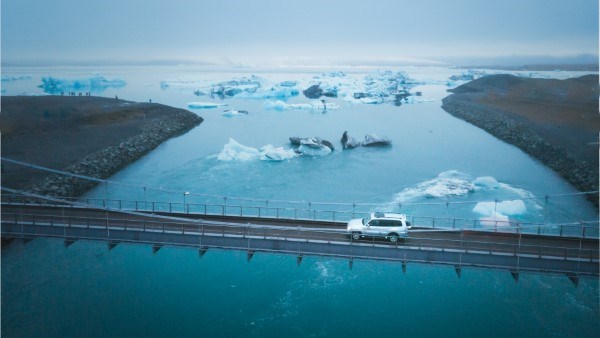
Day 6: Lagarfljót, Egilsstaðir, and Seyðisfjörður
Make your way inland along Route 1 towards Egilsstaðir, the capital of the East. Instead of stopping right away, drive straight down to Lagarfljót, the long and narrow lake that the town sits on. At its south eastern tip, you’ll find the valley that holds Hengifoss, East Iceland’s most famous waterfall. While you can see it from the parking area, it actually takes a good hour or so to reach the top of the hiking trail where you can really appreciate the red clay rocks behind the rush of water that has made it so famous.
After your hike, drive back up to Egilsstaðir (a good place to stock up on groceries) and then make the drive over the mountain pass towards Seyðisfjörður. The scenic views make this little detour worth it alone, but couple that with Seyðisfjörður’s charm and beauty and you’ll quickly realize why this is many camper’s favorite town. Spend the afternoon wandering between the colorful houses, checking out the arts and crafts stores run by the locals, and grabbing a bite to eat at one of the restaurants. If it’s open, we always recommend trying the sushi at Nord Austur.
Do you think you have extra time? check out our in-depth guide to the east fjords
Day 7: Dettifoss and Mývatn
Hit the road early in the morning, driving back across the mountain pass and joining up with the ring road heading northwest. Watch from behind the windshield as the scenery changes dramatically, from the rolling green mountains of the East into the volcanic and desolate plains of the north. Turn onto the road heading north along the western edge of Jökulsárgljúfur canyon until you reach the parking area for Dettifoss, Europe’s most powerful waterfall. Take your time admiring the different views, and don’t forget to check out the waterfall Selfoss a short walk south along the canyon. Afterward, head back south again until you meet the ring road again. Enjoy the smooth road on your way to the geothermal area of Hverir, and the volcanic caldera up at Krafla.
After you’ve had your fill of the volcanic scenery, continue Lake Mývatn, taking a nice drive around the lake to stopping off at the major sights along the way. If you’re looking for a hot spring, the Mývatn Nature Baths are a good stop (albeit an expensive one). When the day is finished, make the relaxing drive northwest along route 87 to the Heiðarbær Campsite for the night.
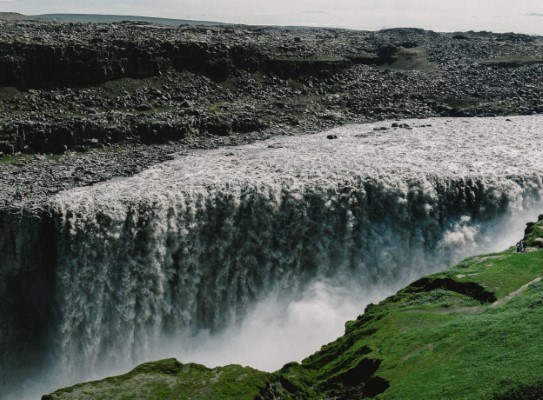
Day 8: Whale Watching and Akureyri
It’s another early start as you make the short drive into Húsavík to catch the morning’s whale watching tours. Success rates on these tours are incredible, and it’ll be a highlight of your camper trip. When you’ve returned, you’ve got a lazy afternoon in store. make the drive down to Akureyri with a stop at Goðafoss on the way. In town, have a bit of a poke around and a rest, as you’ve been on the road for 10 days now with hardly a moment to relax. Camp the night just outside of Akureyri in Hamrar, the beautiful forested recreational area.
Day 9: Hot Springs in Northwest Iceland
Well-rested? Good. It’s time to hit the road again and pack as much as you can into your last days in Iceland. Day 11 is going to be a big drive, but we’ll punctuate it with some lovely hot springs; a nice way to ease back into the trip.
There are two options to choose from (or both if you’re feeling it). The first is the swimming pool Hofsós on the western edge of the Tröllaskagi Peninsula. This swimming spot has gained in popularity over recent years thanks to its spectacular scenery and its design; it’s one of the only infinity pools in Iceland. The second option is across the fjord, and a good choice if you’re in the mood for something a bit more natural: the hot spring Grettislaug. You can’t go wrong here, as we love both swimming spots equally.
After your steamy dip, continue through the town Blönduós and then swing north from the ring road to visit Hvítserkur, also known as the elephant rock. Loop around the peninsula, pulling in at the several signposted lookouts where you can get up close to the seal colonies that call this part of Iceland home. You can find out all about them at the Seal Centre in Hvammstangi, which is also the location of your campsite for the evening.
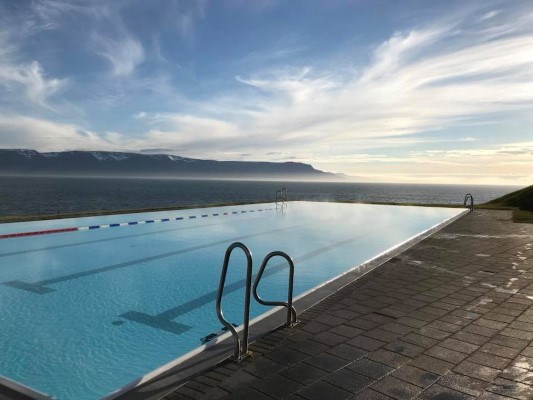
Day 10: The Westfjords
It’s time to make the long drive towards Ísafjörður. The total drive time is just under 5 hours from Hvammstangi, but there are a few possible stops along the way. The first is at the Museum of Icelandic Sorcery and Witchcraft in Hólmavík, where you can see the famed ‘Necropants’, a pair of pants made from human skin said to bring the wearer unlimited wealth. The second stop is the beautiful hot spring Hörgshliðarlaug, a small pool on the edge of the quiet Mjóifjörður.
If you’re after more museums, there’s also the Arctic Fox Centre in Súðavík, just around the corner from Ísafjörður. You’ll be spending the night at the campsite in Ísafjörður, located just outside of town next to a small forest. If you’re enjoying the drive, another option could be to get a jumpstart on day 11 by continuing to another campsite in the Westfjords: both Flateyri and Thingeyri are good options.
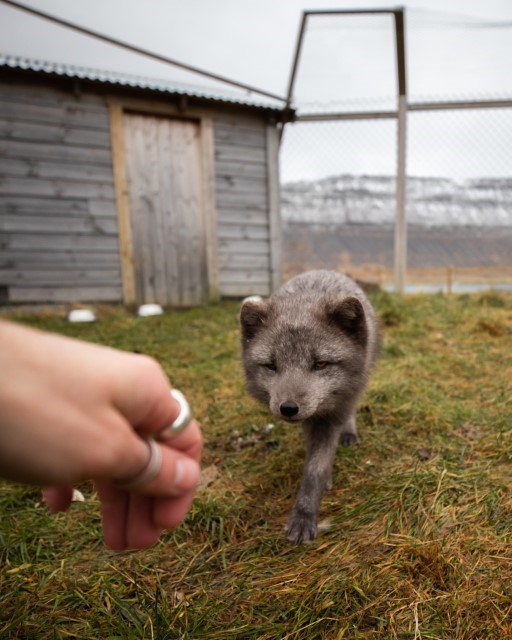
Day 11: Dynjandi and Látrabjarg
Get up early because this is going to be one of the biggest days yet, aiming to take in both Dynjandi waterfall and the Látrabjarg bird cliffs, two of the Westfjords’ biggest natural attractions. Driving through the epic scenery in this region is also an attraction, so don’t worry too much about the long driving time.
Dynjandi is an epic waterfall that tumbles down over a set of cliffs that resemble a giant’s staircase. There are walking trails that let you get right up to the base of the falls, with great views over the fjord. This is one of the most beautiful waterfalls in the country. Látrabjarg is an area of cliffs, Iceland’s westernmost point and a hotspot for sighting puffins during the summer. The dramatic area is a bit of effort to get to, but it's unlike any of the other cliffs in the country. Finish up by camping at Flókalundur. It’s right next to the hot pot Hellulaug, and you’ll be catching the ferry over to the Snæfellsnes Peninsula in the morning from just down the road.
Day 12: Snæfellsnes Peninsula
Wake up early to catch the ferry across Breiðafjörður, the massive fjord that separates the Westfjords from the Snæfellsnes Peninsula. Dotted with islands, birds, seals, and whales, it’s a highlight of any campervan trip.
Snæfellsnes has plenty to offer, see our special Snæfellsnes guide.
Once you’ve arrived in Stykkishólmur, skip town and head straight to the next few destinations on the peninsula: Berserkjahraun lava field, an under-the-radar gem of a lava field, and Kirkjufell, often touted as being Iceland’s most photographed mountain. There’s plenty of time for wanderings Spend the night in the car park of the Freezer Hostel and Culture Centre and visit the bar inside where there are often live events like trivia, comedy, music or theatre.
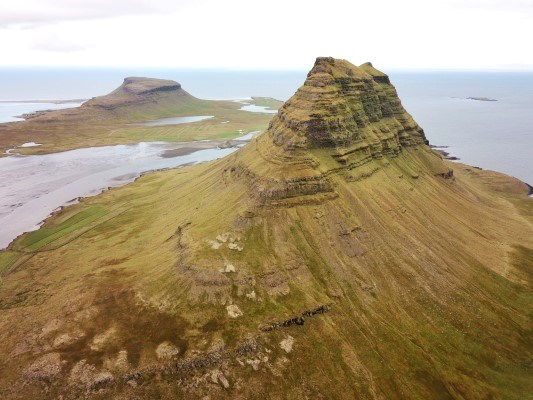
Day 13: Snæfellsjökull National Park and the Southern Shore
Get started early, as there are a lot of stops to make in the National Park that covers the end of the peninsula. All of it is dominated by the perfect cone-shaped volcano Snæfellsjökull, glowing white in the sun when it’s not shrouded in clouds. To find out what you’ll be seeing here, make sure to check out our in-depth guide to the Snæfellsnes Peninsula.
After you’ve driven along the southern shore, head further west inland to Hraunfossar waterfall, a peaceful area of lava fields and rushing water. Camp the night in Akranes, from where you can see Reykjavík on a clear day.
Day 14: Glymur Waterfall and Reykjavík
Your last day with the camper is going to be an easy drive back into Reykjavík. Depending on your flight and drop off date, you can either drive straight back into the city to return the camper and explore the capital for a little while or arrive in the city campsite later that night and return the camper in the morning. If you fall under the latter option and have more time, we highly recommend tackling the hike to Glymur. The trailhead is at the base of Hvalfjörður, the challenging track leading up one side of a canyon to the epic waterfall at the top. The return hike takes around 3-4 hours and is the perfect way to end your trip in Iceland.
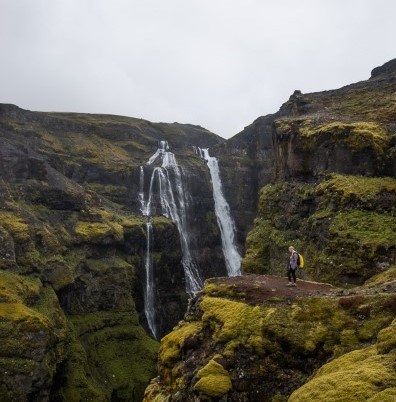
Related articles
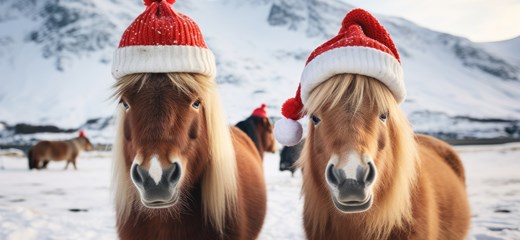
Iceland in December: Christmas and New Years Eve
Iceland in December is a magical time. Discover how to make the most of a winter campervan trip in December in Iceland.
Read more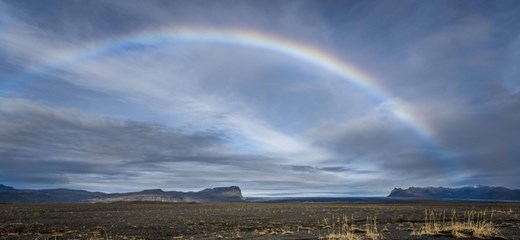
The Best 5-Day Ring Road Itinerary
Not everyone has a whole lot of time to spare on vacation. If you want to do Iceland’s ring road in 5 days without missing the highlights, this itinerary is for you. Includes Thingvellir National Park and Gullfoss waterfall.
Read more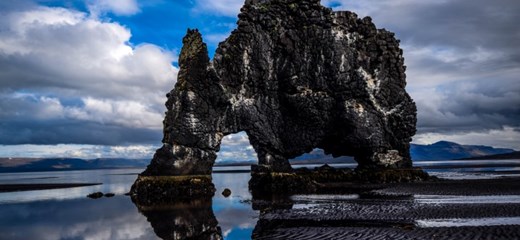
Self-Drive Itinerary: The Arctic Coast Way
A campervan itinerary for Iceland’s newest tourist route that takes in the wild, isolated and powerful northern coast.
Read more James Taylor
James Taylor